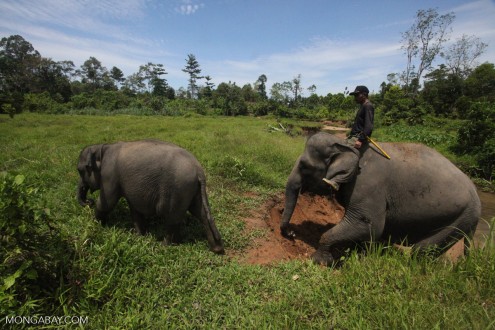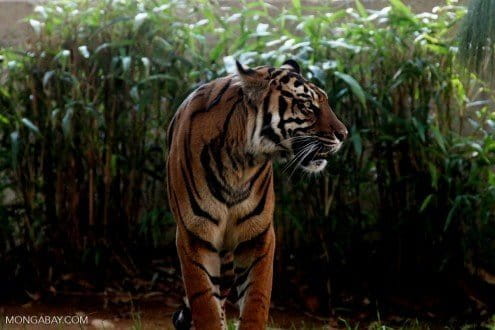- CITES, the international treaty that regulates the trade in wildlife products, dates back to 1975, but some of the systems it uses have not changed in that time.
- Campaigners say this lack of modernization has allowed the illegal wildlife trade to proliferate to the tune of more than $250 billion a year.
- Better regulation would reduce the scale of the illegal wildlife trade and ensure legal commerce is truly sustainable, they say.
Groundbreaking reforms to the $320 billion legal wildlife trade are being put up for discussion at a major international conference this month as campaigners seek to modernize a system they say hasn’t changed in nearly 50 years.
Trade in everything from rhino horn and elephant ivory to python skins, wild orchids and timber is regulated by the Convention on International Trade in Endangered Species (CITES), a treaty dating back to 1975 and backed by more than 180 countries around the world.
But campaigners say that the way in which CITES manages the global wildlife trade has not been updated since it was first set up. In particular, it still relies on a paper-based permit system that does not integrate with international customs protocols, leading to a lack of transparency and traceability in the industry.
In addition, the basis on which CITES operates — to list those species for which trade is limited or banned completely — is the opposite of many other industries, campaigners say. It should be reversed, they contend, so that those only those species in which trade is permitted are listed, and those wishing to profit from the trade must demonstrate that it is sustainable.

Lynn Johnson is the CEO and founder of the Australia-based nonprofit Nature Needs More, which initially looked at the illegal trade in wildlife products and quickly realized there were many fundamental loopholes and flaws in the legal system that needed addressing first.
“We started to look at all the research that had been done, and the two major pieces of work we found was one study that showed that only 7.3 percent of CITES permits were discrepancy-free, and research published this year which showed that it took an average of 12 years for a species listed on the IUCN Red List and therefore at risk of extinction to be regulated under CITES,” Johnson said.
Discrepancies in the permit system could be as simple as officials not recording how many of a particular item are being exported, according to Peter Lanius, a co-director of Nature Needs More. “Most of these permits are filled in by hand, and the people doing it lack the training or the knowledge to do it properly,” he said.
Johnson and Lanius say the permit system is so antiquated that it allows the illegal wildlife trade to flourish; the latest figure for the scale of this trade is $258 billion a year. They say that since 2010, CITES and the signatory countries have discussed creating a wholly electronic system that is fully integrated with customs, at a cost of an estimated $40 million. To date no one has been prepared to fund it.

Conservation groups, which attend CITES conferences but in a non-voting capacity, have not given the Nature Needs More campaign their whole-hearted support, say experts. Shruti Suresh, the senior wildlife campaigner for the U.K.-based Environmental Investigation Agency (EIA), described this year’s CITES conference as a “critical opportunity” to increase protection for species threatened by the wildlife trade.
“While CITES does have its shortcomings, it is currently the primary internationally binding treaty dedicated to addressing trade in animal and plant species of concern,” she said, “and we need to ensure that the precautionary approach is at the heart of any changes to the CITES framework.”
Mark Jones, head of policy for the U.K.-based Born Free Foundation, said that although the wildlife trade continued to devastate the welfare of individual animals and the conservation of many species, CITES was a vital tool for reducing its impact.
“The current systems for regulating and managing wildlife trade are clearly failing to protect wildlife and biodiversity across the globe,” Jones added.
Decisions made by governments at CITES should not serve the commercial interests of traders, he said. “To this end, we fully support any measures aimed at reducing wildlife trade and improving associated monitoring and law enforcement processes through CITES and other mechanisms.”

Johnson said conservation NGOs tend to be focused on the protection of individual species, rather than how the system works as a whole.
“A lot of individuals in the larger NGOs said to us, ‘We are only at the working group meetings by grace and favor of signatory countries. If we challenge them too much, we [could be] uninvited, and if we are uninvited, that impacts on our donor-funding opportunities.’”
According to Nature Needs More, creating a better regulated legal wildlife trade could have huge knock-on impacts on the illegal one.
“We have looked at different types of industries, from pharmaceuticals to airlines parts, and speaking to people, there is an expectation that [the trade in] illicit products stays under 10 percent if you have a system that is well regulated,” Johnson said. “But when you are talking about the illicit trade in endangered species being up to $260 billion, then you are talking 80 percent of the legal trade.”
If a figure of 10 percent were attained, then the illegal wildlife trade would be reduced from one worth an estimated $260 bn to £32bn a year.
Donalea Patman, CEO and founder of For the Love of Wildlife, which is partnering with Nature Needs More in efforts to modernize CITES, said there was a lack of investment in wildlife-trade regulations in general. Some 36,000 species are listed by CITES, but Patman says Australian customs officials get three hours’ training in how to identify all of them.

“When it comes to ivory, auction houses and antique stores tell their clients that if they want to take ivory out of the country, just to say it’s resin or camel bone, because the customs guys don’t know how to be identify it,” she said. “Customs officials also say that, even if they confiscate some items, it is never reported because it is not a priority. They are looking for drugs or firearms, and wildlife products are only found because they are looking for other things, so it is incidental.”
Johnson said it was time, at least for now, to put the argument about whether we should be trading in wildlife at all to one side. “We’ve had this ideological debate of pro-trade versus no-trade, so let’s … accept the fact there will be trade and let’s just fix it,” she said. “If we have to have it — and it’s definitely the model of choice right now — then at least let’s fix it.”
The reform proposals have to be put forward by one of the signatory countries at the CITES conference, which will be held in Geneva from Aug. 17 to 28, and Johnson and Patman said they would like it to be a range-state one (in Africa or Asia, for example). They said the Australian government has expressed its support, as has the EU.
Mongabay contacted the CITES Secretariat for comment, but did not receive any response as of the time this article was published.
Banner image: Rhinos enjoying a mud wallow at the Sumatran Rhino Sanctuary in Way Kambas National Park. Photo by Rhett Butler/Mongabay.
About the reporter: James Fair is a wildlife conservation and environmental journalist based in England. You can find him on Twitter at @Jamesfairwild.
FEEDBACK: Use this form to send a message to the editor of this article. If you want to post a public comment, you can do that at the bottom of the page.
